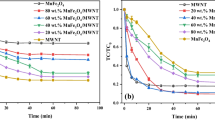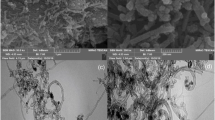Abstract
Application of magnetite nanoparticles (CuFe2O4/GO) were anchored on graphene oxide (GO), as a Heterogeneous nanocomposite for activating of peroxymonosulfate (PMS) into Metronidazole (MNZ) destruction. The effect of solution pH, reaction time, effectiveness of water matrix components and trapping factors, different catalyst concentrations, PMS and contaminants were evaluated as operating factors on the efficiency of MNZ degradation. Also, mineralization, stability, reactivity and Recycling tests of the catalyst, and the degradation kinetics were performed. MNZ degradation and mineralization were obtained under optimal conditions (0.2 g/L catalyst, pH = 5, 30 mg/L MNZ and 2 mM PMS), 100% and 41.02%, respectively over 120 min. Leaching of Fe and Cu was found <0.2 mg/L for CuFe2O4/GO showed a high stability of catalyst, and a significant recyclability was achieved CuFe2O4/GO within 5 times consecutive use. MNZ degradation affected by anions was reduced as follows: HCO3− > NO3− > Cl− > SO42−. The experimental data were very good agreement with pseudo-first-order kinetic model, and during quenching tests SO4•- radicals played a dominant role in the degradation process of MNZ. As a result, the CuFe2O4/GO/PMS system can be described as a promising activation of PMS in MNZ degradation, due to its high stability, reusability and good catalyst reactivity, and the production of reactive species simultaneously.







Similar content being viewed by others
References
Fick J, Söderström H, Lindberg RH, Phan C, Tysklind M, Larsson DJ. Contamination of surface, ground, and drinking water from pharmaceutical production. Environ Toxicol Chem. 2009;28(12):2522–7.
Noroozi R, Gholami M, Farzadkia M, Jonidi Jafari A. Degradation of ciprofloxacin by CuFe2O4/GO activated PMS process in aqueous solution: performance, mechanism and degradation pathway. Int J Environ Anal Chem. 2020:1–22.
Khan NA, Khan SU, Ahmed S, Farooqi IH, Yousefi M, Mohammadi AA. and Changani F. Recent trends in disposal and treatment technologies of emerging-pollutants-A critical review. TrAC Trends Anal Chem. 2020;122:115744.
Kafaei R, Papari F, Seyedabadi M, Sahebi S, Tahmasebi R, Ahmadi M, et al. Occurrence, distribution, and potential sources of antibiotics pollution in the water-sediment of the northern coastline of the Persian Gulf. Iran Science of the Total Environment. 2018;627:703–12.
Petrie B, Barden R, Kasprzyk-Hordern B. A review on emerging contaminants in wastewaters and the environment: current knowledge, understudied areas and recommendations for future monitoring. Water Res. 2015;72:3–27.
Azamateslamtalab E, Madani M, Ramavandi B, Mohammadi R. Sonication alkaline–assisted preparation of Rhizopus oryzae biomass for facile bio-elimination of tetracycline antibiotic from an aqueous matrix. Environ Sci Pollut Res. 2020:1–10.
Khan NA, Ahmed S, Farooqi IH, Ali I, Vambol V, Changani F, et al. Occurrence, sources and conventional treatment techniques for various antibiotics present in hospital wastewaters: a critical review. TrAC Trends Anal Chem. 2020;129:115921.
Pan Y, Li X, Fu K, Deng H, Shi J. Degradation of metronidazole by UV/chlorine treatment: efficiency, mechanism, pathways and DBPs formation. Chemosphere. 2019;224:228–36.
Wang X, Du Y, Ma J. Novel synthesis of carbon spheres supported nanoscale zero-valent iron for removal of metronidazole. Appl Surf Sci. 2016;390:50–9.
Ramavandi B, Akbarzadeh S. Removal of metronidazole antibiotic from contaminated water using a coagulant extracted from Plantago ovata. Desalin Water Treat. 2015;55(8):2221–8.
Fang Z, Chen J, Qiu X, Qiu X, Cheng W, Zhu L. Effective removal of antibiotic metronidazole from water by nanoscale zero-valent iron particles. Desalination. 2011;268(1–3):60–7.
Sepehr MN, Al-Musawi TJ, Ghahramani E, Kazemian H, Zarrabi M. Adsorption performance of magnesium/aluminum layered double hydroxide nanoparticles for metronidazole from aqueous solution. Arab J Chem. 2017;10(5):611–23.
Fakhravar S, Farhadian M, Tangestaninejad S. Excellent performance of a novel dual Z-scheme Cu2S/Ag2S/BiVO4 heterostructure in metronidazole degradation in batch and continuous systems: immobilization of catalytic particles on α-Al2O3 fiber. Appl Surf Sci. 2020;505:144599.
Azadbakht F, Esrafili A, Yeganeh Badi M, Sajedifar J, Amiri M, Gholami M. Efficiency of persulfate-based advanced oxidation process (UV/Na2S2O8) in removal of metronidazole from aqueous solutions. J Mazandaran Univ Med Sci. 2017;27(154):119–29.
Dai Q, Zhou J, Weng M, Luo X, Feng D, Chen J. Electrochemical oxidation metronidazole with co modified PbO2 electrode: degradation and mechanism. Sep Purif Technol. 2016;166:109–16.
Görmez F, Görmez Ö, Gözmen B, Kalderis D. Degradation of chloramphenicol and metronidazole by electro-Fenton process using graphene oxide-Fe3O4 as heterogeneous catalyst. J Environ Chem Eng. 2019;7(2):102990.
Wang Q, Cai Z, Huang L, Pan Y, Quan X, Puma GL. Intensified degradation and mineralization of antibiotic metronidazole in photo-assisted microbial fuel cells with Mo-W catalytic cathodes under anaerobic or aerobic conditions in the presence of Fe (III). Chem Eng J. 2019;376:119566.
Khan A, Liao Z, Liu Y, Jawad A, Ifthikar J, Chen Z. Synergistic degradation of phenols using peroxymonosulfate activated by CuO-Co3O4@ MnO2 nanocatalyst. J Hazard Mater. 2017;329:262–71.
Damiri F, Dobaradaran S, Hashemi S, Foroutan R, Vosoughi M, Sahebi S, et al. Waste sludge from shipping docks as a catalyst to remove amoxicillin in water with hydrogen peroxide and ultrasound. Ultrason Sonochem. 2020:105187.
Farhadi N, Tabatabaie T, Ramavandi B, Amiri F. Optimization and characterization of zeolite-titanate for ibuprofen elimination by sonication/hydrogen peroxide/ultraviolet activity. Ultrason Sonochem. 2020:105122.
Jafari AJ, Kakavandi B, Jaafarzadeh N, Kalantary RR, Ahmadi M, Babaei AA. Fenton-like catalytic oxidation of tetracycline by AC@ Fe3O4 as a heterogeneous persulfate activator: adsorption and degradation studies. J Ind Eng Chem. 2017;45:323–33.
Khan AH, Khan NA, Ahmed S, Dhingra A, Singh CP, Khan SU, et al. Application of advanced oxidation processes followed by different treatment technologies for hospital wastewater treatment. J Clean Prod. 2020:122411.
Ren Y, Lin L, Ma J, Yang J, Feng J, Fan Z. Sulfate radicals induced from peroxymonosulfate by magnetic ferrospinel MFe2O4 (M= co, cu, Mn, and Zn) as heterogeneous catalysts in the water. Appl Catal B Environ. 2015;165:572–8.
Deng J, Feng S, Zhang K, Li J, Wang H, Zhang T, et al. Heterogeneous activation of peroxymonosulfate using ordered mesoporous Co3O4 for the degradation of chloramphenicol at neutral pH. Chem Eng J. 2017;308:505–15.
Li X, Xiao B, Wu M, Wang L, Chen R, Wei Y, et al. In-situ generation of multi-homogeneous/heterogeneous Fe-based Fenton catalysts toward rapid degradation of organic pollutants at near neutral pH. Chemosphere. 2020;245:125663.
Li J, Li Y, Xiong Z, Yao G, Lai B. The electrochemical advanced oxidation processes coupling of oxidants for organic pollutants degradation: a mini-review. Chin Chem Lett. 2019;30(12):2139–46.
Khaghani R, Kakavandi B, Ghadirinejad K, Fard ED, Asadi A. Preparation, characterization and catalytic potential of γ-Fe2O3@ AC mesoporous heterojunction for activation of peroxymonosulfate into degradation of cyfluthrin insecticide. Microporous Mesoporous Mater. 2019;284:111–21.
Chen L, Ding D, Liu C, Cai H, Qu Y, Yang S, et al. Degradation of norfloxacin by CoFe2O4-GO composite coupled with peroxymonosulfate: a comparative study and mechanistic consideration. Chem Eng J. 2018;334:273–84.
Li H, Gao Q, Wang G, Han B, Xia K, Zhou C. Architecturing CoTiO3 overlayer on nanosheets-assembled hierarchical TiO2 nanospheres as a highly active and robust catalyst for peroxymonosulfate activation and metronidazole degradation. Chem Eng J. 2020;392:123819.
MirzaHedayat B, Noorisepehr M, Dehghanifard E, Esrafili A, Norozi R. Evaluation of photocatalytic degradation of 2, 4-Dinitrophenol from synthetic wastewater using Fe3O4@ SiO2@ TiO2/rGO magnetic nanoparticles. J Mol Liq. 2018;264:571–8.
Foroutan R, Mohammadi R, Ramavandi B. Elimination performance of methylene blue, methyl violet, and Nile blue from aqueous media using AC/CoFe 2 O 4 as a recyclable magnetic composite. Environ Sci Pollut Res. 2019;26(19):19523–39.
Foroutan R, Mohammadi R, Ramavandi B, Bastanian M. Removal characteristics of chromium by activated carbon/CoFe 2 O 4 magnetic composite and Phoenix dactylifera stone carbon. Korean J Chem Eng. 2018;35(11):2207–19.
Zhang T, Zhu H, Croué J-P. Production of sulfate radical from peroxymonosulfate induced by a magnetically separable CuFe2O4 spinel in water: efficiency, stability, and mechanism. Environ Sci Technol. 2013;47(6):2784–91.
Nirumand L, Farhadi S, Zabardasti A. Magnetically separable Ag/CuFe2O4/reduced Graphene oxide ternary Nanocomposite with high performance for the removal of Nitrophenols and dye pollutants from aqueous media. Acta Chim Slov. 2018;65(4):919–31.
Noroozi R, Al-Musawi TJ, Kazemian H, Kalhori EM, Zarrabi M. Removal of cyanide using surface-modified Linde type-a zeolite nanoparticles as an efficient and eco-friendly material. J Water Process Eng. 2018;21:44–51.
Tu Y-J, You C-F, Chen M-H, Duan Y-P. Efficient removal/recovery of Pb onto environmentally friendly fabricated copper ferrite nanoparticles. J Taiwan Inst Chem Eng. 2017;71:197–205.
Tang Y, Guo H, Xiao L, Yu S, Gao N, Wang Y. Synthesis of reduced graphene oxide/magnetite composites and investigation of their adsorption performance of fluoroquinolone antibiotics. Colloids Surf A Physicochem Eng Asp. 2013;424:74–80.
Wu L-K, Wu H, Zhang H-B, Cao H-Z, Hou G-Y, Tang Y-P, et al. Graphene oxide/CuFe2O4 foam as an efficient absorbent for arsenic removal from water. Chem Eng J. 2018;334:1808–19.
Sharifi S, Nabizadeh R, Akbarpour B, Azari A, Ghaffari HR, Nazmara S, et al. Modeling and optimizing parameters affecting hexavalent chromium adsorption from aqueous solutions using Ti-XAD7 nanocomposite: RSM-CCD approach, kinetic, and isotherm studies. J Environ Health Sci Eng. 2019;17(2):873–88.
Foroutan R, Peighambardoust SJ, Mohammadi R, Omidvar M, Sorial GA, Ramavandi B. Influence of chitosan and magnetic iron nanoparticles on chromium adsorption behavior of natural clay: adaptive neuro-fuzzy inference modeling. Int J Biol Macromol. 2020;151:355–65.
Zhang X, Feng M, Qu R, Liu H, Wang L, Wang Z. Catalytic degradation of diethyl phthalate in aqueous solution by persulfate activated with nano-scaled magnetic CuFe2O4/MWCNTs. Chem Eng J. 2016;301:1–11.
Fan J, Qin H, Jiang S. Mn-doped g-C3N4 composite to activate peroxymonosulfate for acetaminophen degradation: the role of superoxide anion and singlet oxygen. Chem Eng J. 2019;359:723–32.
Ammar HB, Brahim MB, Abdelhédi R, Samet Y. Enhanced degradation of metronidazole by sunlight via photo-Fenton process under gradual addition of hydrogen peroxide. J Mol Catal A Chem. 2016;420:222–7.
Rao Y, Qu L, Yang H, Chu W. Degradation of carbamazepine by Fe (II)-activated persulfate process. J Hazard Mater. 2014;268:23–32.
Hu L, Zhang G, Liu M, Wang Q, Dong S, Wang P. Application of nickel foam-supported Co3O4-Bi2O3 as a heterogeneous catalyst for BPA removal by peroxymonosulfate activation. Sci Total Environ. 2019;647:352–61.
Kong J, Li R, Wang F, Chen P, Liu H, Liu G, et al. Sulfate radical-induced transformation of trimethoprim with CuFe 2 O 4/MWCNTs as a heterogeneous catalyst of peroxymonosulfate: mechanisms and reaction pathways. RSC Adv. 2018;8(44):24787–95.
Deng J, Shao Y, Gao N, Tan C, Zhou S, Hu X. CoFe2O4 magnetic nanoparticles as a highly active heterogeneous catalyst of oxone for the degradation of diclofenac in water. J Hazard Mater. 2013;262:836–44.
Wang Y, Tian D, Chu W, Li M, Lu X. Nanoscaled magnetic CuFe2O4 as an activator of peroxymonosulfate for the degradation of antibiotics norfloxacin. Sep Purif Technol. 2019;212:536–44.
Xu L, Chu W, Gan L. Environmental application of graphene-based CoFe2O4 as an activator of peroxymonosulfate for the degradation of a plasticizer. Chem Eng J. 2015;263:435–43.
Acknowledgments
Financial support for this study is provided by 32659 project number from Iran University of Medical Sciences, Tehran, Iran.
Author information
Authors and Affiliations
Corresponding author
Ethics declarations
Conflict of interest
The authors of this article declare that they have no conflict of interests.
Additional information
Publisher’s note
Springer Nature remains neutral with regard to jurisdictional claims in published maps and institutional affiliations.
Rights and permissions
About this article
Cite this article
Noroozi, R., Gholami, M., Farzadkia, M. et al. Catalytic potential of CuFe2O4/GO for activation of peroxymonosulfate in metronidazole degradation: study of mechanisms. J Environ Health Sci Engineer 18, 947–960 (2020). https://doi.org/10.1007/s40201-020-00518-4
Received:
Accepted:
Published:
Issue Date:
DOI: https://doi.org/10.1007/s40201-020-00518-4




